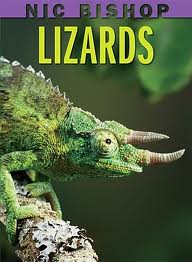Lizards

by Nic Bishop. ![]() Nonfiction. 48 pages. Grades PreK-9.
Nonfiction. 48 pages. Grades PreK-9.
Find this book: Amazon

Review

Lizards is a stunning photo essay. The gliding gecko from Southeast Asia drifts down from it's perch in a stop-action, multi-exposure photo on the opening page—its cat eye looking out at us, its four webbed feet splayed with translucent skin between its toes as the skin along its sides spreads to catch more air.
This book is a visual feast with lush photos brimming with enough detail to allow careful observation of individual traits. You can feel the texture of each individual scale, eyelid, nostril and tooth. Each photo includes a note about the degree of magnification or reduction shown.
This book is rich with examples of these reptiles' adaptations. The scales of a lizard are made of the same material as our fingernails and are waterproof, which allows many lizards to live in the desert without drying out. Some desert lizards avoid the heat by living underground. The shield-tailed agama blocks the opening of its burrow with the rounded spiny shield-shaped end of its tail when it is sleeping. The web-footed gecko uses its specialized feet like snowshoes to stay atop powdery sand. The thorny devil has tiny channels on its belly that direct water up to its mouth when they are rubbed on damp sand. Chameleons have prehensile tails to help them climb and perch.
There's wonderfully detailed science information, such as how the molecules on the hairs of the tow pads of some geckos cling to the molecules of the things they are walking on so that they can do things like walk across a ceiling without falling off.
Many photos also include information on which country or continent the lizard can be found, so there are opportunities to integrate this topic with geography, especially geography units which survey large areas of the world or geography units on deserts or the rain forest. Bishop shows us glamour shots of the crocodile skink from New Guinea, marine iguanas from the Galapagos Islands, the shield-tailed agama from Africa, the knob-tailed gecko from Australia, the thorny devil from Australia, the Jackson's chameleon from Africa, the flying dragon from Southeast Asia, the leaf-tailed gecko from Madagascar, the basilisk lizard from South America and Central America, the frilled dragon from Australia, the sandfish of northern Africa and western Asia, and African Nile monitors from Africa.
There's a fascinating afterword by the author telling about the taking of two of the twenty-one photos in the book. He traveled to a remote area of Australia to photograph the thorny devil only to find that the ranger who had told him that along Shark Bay Road, "you see them all the time" hadn't actually seen one in four years. Nic Bishop continued to search the area for days and eventually got the knock-out photo he was looking for.
He then tells the story of trying to take a photo of a basilisk lizard running across the surface of water, which they do to escape predators. For this, he used lizards raised in captivity and built a pond in his garage for the high tech camera equipment. When he couldn't get them to run on the surface, he rebuilt the pond inside his house and, voila, the amazing fold-out spread in the center of the book showing the lizard at three stop-action moments as it skips across the surface on it's hindllegs with water droplets scattering and forelegs stretched out to the sides for balance like a tightrope walker dancing across the page.
(Continued Below)
Advertisement:
(Continued Below)
Advertisement:
(Continued Below)
Advertisement:

Related Areas Within Carol Hurst's Children's Literature Web Site
- Deserts through Books for Kids and Teens: Featured Subject Classroom Unit article with classroom discussion and activity ideas, picture books, nonfiction and novels.
- Animals: Recommended Childrens' Books for the Classroom
An Annotated List of Some of Our Favorites for Grades PreK-9:
http://www.carolhurst.com/subjects/animals.html

